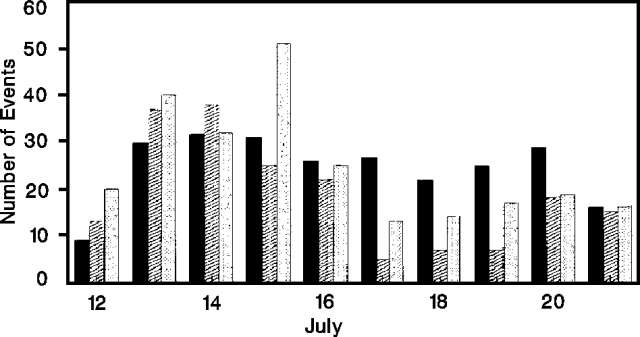Report on Arenal (Costa Rica) — July 1992
Bulletin of the Global Volcanism Network, vol. 17, no. 7 (July 1992)
Managing Editor: Lindsay McClelland.
Arenal (Costa Rica) Lava extrusion; Strombolian activity; pyroclastic flows
Please cite this report as:
Global Volcanism Program, 1992. Report on Arenal (Costa Rica) (McClelland, L., ed.). Bulletin of the Global Volcanism Network, 17:7. Smithsonian Institution. https://doi.org/10.5479/si.GVP.BGVN199207-345033
Arenal
Costa Rica
10.463°N, 84.703°W; summit elev. 1670 m
All times are local (unless otherwise noted)
Extrusion of block lava, sporadic Strombolian activity, and gas emission were continuing in early August. Small pyroclastic flows were occasionally generated, as on 4 August at 1543 when one moved W and another S, and the ash column rose more than 1 km above the active summit crater (C). Another pyroclastic flow traveled S at 1604, reaching 1,050 m elevation. Lava continued to flow SW into the forest, advancing 150 m over a 15-day period ending in early August to reach 640 m elevation. Fumarolic activity occurred from the old summit crater (D).
On 12-22 July, personnel from OVSICORI, W. Melson, and a group of SI volunteers carried out 24-hour monitoring of the volcano. They sonically recorded 679 eruption events of three types (figure 49). Some were detected seismically 30 km away (at OVSICORI station JTS). Harmonic and monochromatic tremor were recorded for several-minute periods.
Vegetation on the NE, E, and SE flanks continued to be affected by acid rain and tephra fall. Small cold avalanches occurred in the Calle de Arena and Guillermina quebradas, and the Río Agua Caliente.
Geological Summary. Conical Volcán Arenal is the youngest stratovolcano in Costa Rica and one of its most active. The 1670-m-high andesitic volcano towers above the eastern shores of Lake Arenal, which has been enlarged by a hydroelectric project. Arenal lies along a volcanic chain that has migrated to the NW from the late-Pleistocene Los Perdidos lava domes through the Pleistocene-to-Holocene Chato volcano, which contains a 500-m-wide, lake-filled summit crater. The earliest known eruptions of Arenal took place about 7000 years ago, and it was active concurrently with Cerro Chato until the activity of Chato ended about 3500 years ago. Growth of Arenal has been characterized by periodic major explosive eruptions at several-hundred-year intervals and periods of lava effusion that armor the cone. An eruptive period that began with a major explosive eruption in 1968 ended in December 2010; continuous explosive activity accompanied by slow lava effusion and the occasional emission of pyroclastic flows characterized the eruption from vents at the summit and on the upper western flank.
Information Contacts: E. Fernández, J. Barquero, and V. Barboza, OVSICORI.


